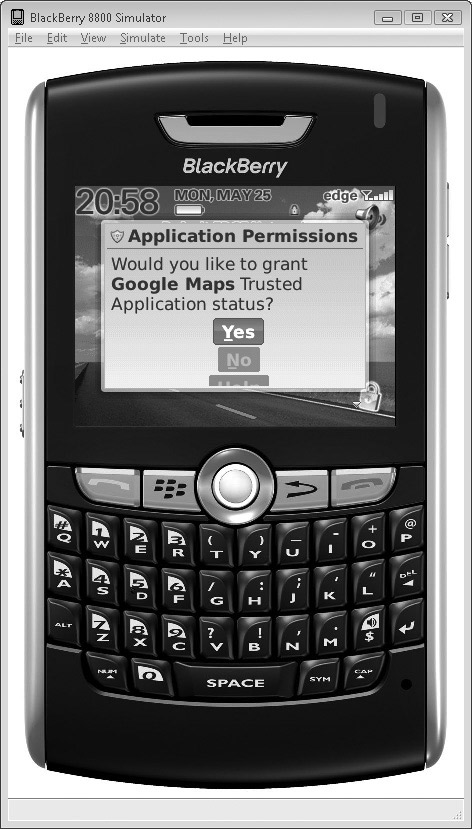Responsible developers should require the user to
explicitly confirm the enabling of geolocation features. They should
also provide an easy interface to disable it. Microsoft provides
explicit guidelines for security and privacy for Windows Mobile 6 on
MSDN at msdn.microsoft.com/en-us/library/bb201944.aspx.
Note that many WM devices
(for example, the HTC Apache) were sold containing a GPS that is only
accessible to the E911 service and cannot be accessed by developers.
Symbian
On the Symbian
platform, signed applications can access the geolocation API without
user interaction. For unsigned applications, users will be prompted upon
install as to whether they want to grant the application this
capability. Positional data is obtained by querying the location server via the RPositionServer, RPositioner, TPositionInfo and TPosition classes (see Listing 1).
Listing 1. Acquiring Positional Information on Symbian
RPositionServer;
RPositioner pos;
User::LeaveIfError(srv.Connect());
CleanupClosePushL(srv);
User::LeaveIfError(pos.Open(srv));
CleanupClosePushL(pos);
pos.getLastKnownPosition(posInfo, status); // cached data from last fix
posInfo.GetPosition(pos);
|
The program can also use NotifyPositionUpdate to request fresh data rather than cached.
BlackBerry
The BlackBerry uses the
standard J2ME geolocation APIs as detailed in the JSR-179 specification.
Positional data can be obtained by instantiating a criteria, setting
its attributes, and passing this to a new LocationProvider instance. Listing 2 provides an example of this.
Listing 2. Creating a JSR-179 LocationProvider
Criteriacr=new Criteria();
cr.setHorizontalAccuracy(500);
cr.setVerticalAccuracy(500);
cr.setCostAllowed(false); // Whether or not services may incur costs
to the user
cr.setPreferredPowerConsumption(Criteria.POWER_USAGE_LOW;
// Three levels of desired power consumption allowed
lp = LocationProvider.getInstance(criteria);
|
Upon installation, the user
will be prompted for the permissions they wish to grant the application.
Afterward, these permissions can be changed in Options | Security
Options | Application (see Figure 1).

Risks of Geolocation Services
Although
mobile geolocation services have resulted in some useful and convenient
mobile applications, these services expand the potential risks to both
the end user and the remote service providers making use of this data.
Any tracking technology has the capacity to make software more
personalized, but this very personalization is what makes it attractive
to law enforcement and civil trial lawyers, as well as other malicious
parties.
Risks to the End User
Positional
data stored on remote servers, when it can be tied to an individual,
introduces a new avenue for data theft. Not only can a compromise of a
sensitive service reveal personal and credit card data, it can also
reveal information about users’ historical whereabouts, potentially over
an extended timeframe. This is not only a breach of user privacy, but
potentially provides information that can be used against a user in
court.
The classic example of this is a
divorce court subpoena, in which a service provider is obligated to
provide positional information to prove or disprove that a party in a
divorce case has been carrying on a covert relationship. This occurs
with some frequency with toll-pass systems such as FasTrak and EZPass
(refer to www.usatoday.com/tech/news/surveillance/2007-08-10-ezpass_N.htm and www.sfgate.com/cgi-bin/article.cgi?f=/c/a/2001/02/12/BU75523.DTL).
Even outside of adulterous activity, positional tracking records have
been subpoenaed as evidence of how much (or little) a person works, both
in divorce courts and other civil cases (see
findarticles.com/p/articles/mi_qn4176/is_20070608/ai_n19294734/?tag=content;col1).
Recently, it has become
fashionable for services to track one’s location and broadcast this to
other users of the service. This raises a whole new set of security
concerns, where other users may use this information for stalking or
harassment, in addition to all of the aforementioned issues. Users must
be extremely vigilant to ensure that services attempting to use data for
this purpose are protecting it appropriately.
Whatever the scenario, it’s a
good idea to keep track of who’s keeping track of you. End users of
geolocation technologies should take the following into account:
Does the application/site have a privacy policy for positional information?
Is data retained or discarded/overwritten?
If data is retained, will records be handed over to law enforcement upon request, or is a court order required?
Note
Remember
in the past that institutions receiving a “National Security Letter”
from the FBI are prohibited from disclosing that they’ve even received a
request, much less that data was shared. As a user, this makes it even
more important to determine what amount and type of data is being
retained.
Does the provider share location data with third parties or store data with them?
Are other users of the service privy to your location data?
Are you able to easily block users?
Is this data transferred over secure channels [that is, Secure Sockets Layer (SSL)]?
Is the data accessible via other means (such as via a website)? Is this site adequately secured?
Risks to Service Providers
By maintaining
extended positional records on users, service providers expose
themselves to the risk of negative publicity from a data breach, legal
or congressional subpoenas, and potential assistance to criminal acts by
allowing third parties to track individual users. Often, this data
isn’t really necessary to provide the required functionality. In some
places, you as a provider will have a legal obligation to follow privacy
guidelines. For example, in the UK, the Data Protection Act requires
that users are made aware of who is tracking them, the purposes for
which their personal data will be collected, and whether the data will
be sent to a third party, including information about data retention and
storage (refer to www.statutelaw.gov.uk/content.aspx?activeTextDocId=3190610). To sum up, positional data is “hot”—you don’t want to store it if there is no compelling need to do so.